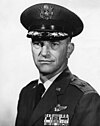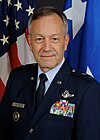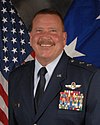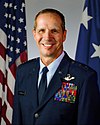
March Air Reserve Base, previously known as March Air Force Base is located in Riverside County, California between the cities of Riverside, Moreno Valley, and Perris. It is the home to the Air Force Reserve Command's Fourth Air Force Headquarters and the host of the 452nd Air Mobility Wing, the largest air mobility wing of the Fourth Air Force. In addition to multiple units of the Air Force Reserve Command supporting Air Mobility Command, Air Combat Command and Pacific Air Forces, March ARB is also home to units from the Army Reserve, Navy Reserve, Marine Corps Reserve, California Air National Guard and the California Army National Guard. For almost 50 years, March AFB was a Strategic Air Command base during the Cold War. The facility covers 2,075 acres of land.

The Air Mobility Command (AMC) is a Major Command (MAJCOM) of the U.S. Air Force. It is headquartered at Scott Air Force Base, Illinois, east of St. Louis, Missouri.

MacDill Air Force Base is an active United States Air Force installation located 4 miles (6.4 km) south-southwest of downtown Tampa, Florida.

Altus Air Force Base is a United States Air Force base located approximately 4 miles (6.4 km) east-northeast of Altus, Oklahoma.

The 452nd Air Mobility Wing is an Air Reserve Component of the United States Air Force. It is assigned to the Fourth Air Force, Air Force Reserve Command, stationed at March Air Reserve Base, California. If mobilized, the Wing is gained by the Air Mobility Command.

The 927th Air Refueling Wing is a combat coded Air Reserve Component (ARC) wing of the United States Air Force. It is assigned to the Fourth Air Force of Air Force Reserve Command (AFRC) and is stationed at MacDill Air Force Base, Florida.

The 940th Air Refueling Wing is part of the Air Reserve Component of the United States Air Force. It is assigned to the Fourth Air Force of the Air Force Reserve Command, is operationally-gained by the Air Mobility Command, and is home stationed at Beale Air Force Base, California.

The 507th Air Refueling Wing is a reserve component flying unit of the United States Air Force. It is assigned to Fourth Air Force of Air Force Reserve Command, stationed at Tinker Air Force Base, Oklahoma with elements at Altus Air Force Base, Oklahoma. The 507th ARW executes air refueling, airlift, and training in support of Air Mobility Command and U.S. Strategic Command's national emergency war order requirements. The wing employs approximately 1,100 men and women made up of a mix of Traditional Reservists, full-time Air Reserve Technicians, AGRs and Air Force civilians. The wing also provides mission support for all other reserve units stationed at Tinker AFB.

The 137th Special Operations Wing is a unit of the Oklahoma Air National Guard located at Will Rogers Air National Guard Base, Oklahoma. If activated to federal service, the wing is gained by Air Force Special Operations Command. During World War II, its predecessor, the 404th Fighter Group, flying Republic P-47 Thunderbolts, provided close air support to troops following the Operation Overlord, the Normandy landing until the close of the war. The wing is entitled to the honors won by the group by temporary bestowal.

The 157th Air Refueling Wing is a unit of the New Hampshire Air National Guard, stationed at Pease Air National Guard Base, Portsmouth, New Hampshire, United States. If activated to federal service, the Wing is gained by the United States Air Force Air Mobility Command.

The 185th Special Operations Squadron is a unit of the Oklahoma Air National Guard's 137th Special Operations Wing, located at Will Rogers World Airport, Oklahoma City, Oklahoma. The 185th is the only National Guard unit to be equipped with the MC-12W. The unit is known as the "Sooners". Famous unit alumni include former Vietnam prisoner of war Brig. Gen. James Robinson "Robbie" Risner and Astronaut Captain Fred Wallace Haise Jr., Apollo 13 Lunar Module Pilot.

The 18th Air Refueling Squadron is a United States Air Force Reserve squadron, assigned to the 931st Air Refueling Wing at McConnell Air Force Base, Kansas. It operates the Boeing KC-135R Stratotanker aircraft conducting air refueling missions. If mobilized the squadron would be gained by Air Mobility Command.

The 54th Air Refueling Squadron is part of the 97th Air Mobility Wing at Altus Air Force Base, Oklahoma. It operates the Boeing KC-135 Stratotanker aircraft conducting air refueling training.

The 91st Air Refueling Squadron is part of the 6th Air Mobility Wing at MacDill Air Force Base, Florida. It operates the Boeing KC-135R Stratotanker aircraft conducting air refueling missions.

The 314th Air Refueling Squadron is an active United States Air Force unit within the Air Force Reserve Command. It is currently assigned to the 940th Air Refueling Wing, based at Beale Air Force Base, California. It was inactivated on 1 July 2009 and reactivated on 1 June 2016.

The 336th Air Refueling Squadron is a United States Air Force Reserve squadron, assigned to the 452d Operations Group, stationed at March Joint Air Reserve Base, California. The squadron shares its aircraft and facility with the 912th Air Refueling Squadron, a USAF Associate Unit assigned to the 92d Air Refueling Wing.

The 756th Air Refueling Squadron is a United States Air Force Reserve squadron, assigned to the 459th Operations Group, stationed at Joint Base Andrews, Maryland.

The 452d Operations Group is the flying component of the 452d Air Mobility Wing, assigned to the United States Air Force Reserve. The group is stationed at March Air Reserve Base, California.

Westover Air Reserve Base is an Air Force Reserve Command (AFRC) installation located in the Massachusetts communities of Chicopee and Ludlow, near the city of Springfield, Massachusetts. Established at the outset of World War II, today Westover is the largest Air Force Reserve base in the United States, home to approximately 5,500 military and civilian personnel, and covering 2500 acres (10 km²). Until 2011, it was a backup landing site for the NASA Space Shuttle and in the past few years has expanded to include a growing civilian access airport sharing Westover's military-maintained runways. The installation was named for Major General Oscar Westover who was commanding officer of the Army Air Corps in the 1930s.

The 107th Attack Wing is a unit of the New York Air National Guard, stationed at Niagara Falls Air Reserve Station, New York. The 107th is equipped with the MQ-9 Reaper. If activated to federal service, the Wing is gained by the United States Air Force's Air Combat Command.




























































